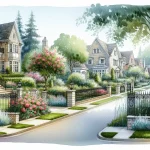Situated within New Orleans, Gentilly Terrace stands as a testament to the city’s architectural legacy and community spirit. Established in the early 20th century, this historic district has played a crucial role in shaping the cultural landscape of the Crescent City.
In This Article
TL;DR
- Gentilly Terrace holds historical significance as one of New Orleans’ earliest planned suburbs, reflecting urban expansion and development.
- The district showcases diverse architectural styles, including Spanish Revival, Craftsman, and California Bungalow homes, highlighting architectural influences and preservation efforts.
- Gentilly Terrace fosters a thriving community with events, festivals, and community centers that promote neighborhood cohesion and cultural expression.
Historical Overview of Gentilly Terrace
The establishment of Gentilly Terrace can be traced back to the early 1900s when real estate developers Edward Lafaye, Michael Baccich, and R.E. Edgar de Montluzin envisioned a modern suburban community on the natural ridge formed by the overflow of Bayou Sauvage. This elevated location made it an attractive site for residential development.
As New Orleans experienced rapid growth, Gentilly Terrace played a crucial role in accommodating the expanding population. Marketed as “Homes Built On Hills,” it offered a desirable living environment away from the city center’s congestion. Gentilly Terrace quickly became a sought-after neighborhood, attracting families and professionals seeking a suburban lifestyle within the city limits.
Throughout its history, notable events like the 1936 devastating fire at the Gentilly Terrace School have shaped the community’s character, highlighting its resilience and the importance of preserving educational institutions.
Architectural Significance
Gentilly Terrace is esteemed for its diverse architectural styles, reflecting various design movements and the visions of prominent architects. The district features a harmonious blend of Spanish Revival, Craftsman, and California Bungalow homes, each with its unique charm and character.
The Spanish Revival style, with stucco exteriors, red-tiled roofs, and arched windows, pays homage to the region’s Spanish colonial heritage. The Craftsman homes, with low-pitched roofs, exposed wooden beams, and wide front porches, exude warmth and craftsmanship.
California Bungalow Homes
Notably, Gentilly Terrace boasts Louisiana’s largest collection of California Craftsman-style architecture. These Arts and Crafts-inspired homes feature distinctive elements like overhanging eaves, tapered columns, and intricate woodwork.
Preservation efforts have played a crucial role in maintaining the architectural integrity of Gentilly Terrace. Local organizations and residents work tirelessly to protect and restore these historic homes, ensuring the district’s unique character is preserved for future generations.
Cultural and Community Life
Gentilly Terrace is a vibrant and diverse community that celebrates its rich cultural heritage through various events and festivals. The district’s cultural makeup reflects the melting pot of New Orleans, with influences from various ethnic groups and traditions.
One of the most anticipated events is the annual neighborhood festival, bringing together residents and visitors to celebrate the community’s spirit. Local musicians, food vendors, and artisans showcase the best of New Orleans’ culture, creating a lively and festive atmosphere.
Community centers and public spaces foster neighborhood cohesion by hosting activities, workshops, and educational programs, providing opportunities for residents to connect, learn, and engage with one another.
Economic Impact and Development
Gentilly Terrace has experienced a resurgence in economic activity, with local businesses and entrepreneurs contributing to the district’s vibrancy. Boutique shops, cafes, and restaurants have breathed new life into the neighborhood, attracting visitors and supporting the local economy.
Future development plans aim to balance preserving the historic character with accommodating growth and modernization. Initiatives focused on sustainable development, green spaces, and pedestrian-friendly infrastructure are being explored to enhance residents’ quality of life while maintaining the district’s unique charm.
Education and Public Institutions
Gentilly Terrace is home to several educational institutions that play a vital role in the community’s development. The district’s schools, ranging from elementary to high school levels, provide quality education and foster pride among residents.
Public institutions, such as libraries and community centers, serve as hubs for learning and personal growth. These facilities offer programs, workshops, and resources, catering to the diverse needs of the community.
Partnerships between educational institutions and local businesses provide students with hands-on learning experiences and career opportunities. These collaborations enrich the educational experience and contribute to the district’s overall economic development.
Environmental and Green Spaces
Gentilly Terrace takes pride in its commitment to environmental sustainability and preserving green spaces. The district boasts several parks and recreational areas, providing residents opportunities to connect with nature and engage in outdoor activities.
Community initiatives focused on environmental education and conservation have gained momentum. Residents actively participate in tree-planting campaigns, recycling programs, and urban gardening projects, fostering environmental stewardship.
These natural oases enhance the aesthetic appeal, improve air quality, and serve as habitats for local wildlife, contributing to the community’s overall well-being.
Challenges and Future Prospects
Like many historic districts, Gentilly Terrace faces challenges in balancing preservation efforts with modern living demands. Aging infrastructure, gentrification pressures, and affordable housing needs require careful consideration and strategic planning.
Community organizations and local authorities collaborate to address these challenges through strategies like implementing sustainable development practices, promoting affordable housing initiatives, and investing in infrastructure improvements to ensure the district’s long-term viability.
Despite the challenges, Gentilly Terrace’s future prospects remain promising. With its rich cultural heritage, architectural significance, and strong community spirit, the district is poised to continue thriving as a vibrant and desirable neighborhood in New Orleans.






